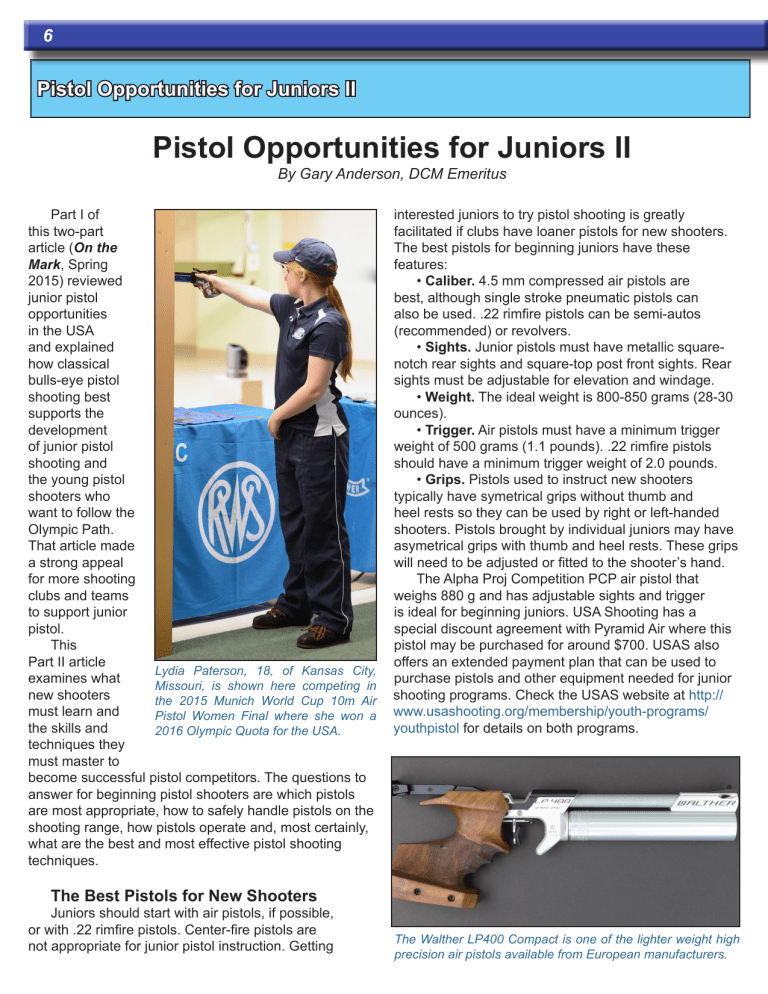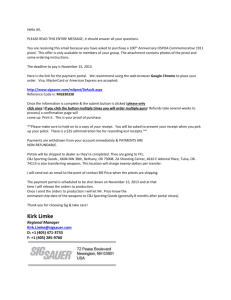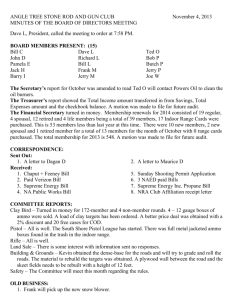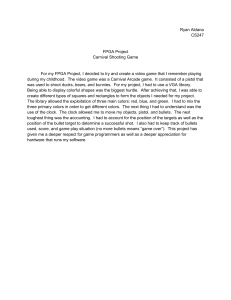Junior Pistol Shooting: Equipment, Safety, and Techniques
advertisement

6 Pistol Opportunities for Juniors II Pistol Opportunities for Juniors II By Gary Anderson, DCM Emeritus Part I of this two-part article (On the Mark, Spring 2015) reviewed junior pistol opportunities in the USA and explained how classical bulls-eye pistol shooting best supports the development of junior pistol shooting and the young pistol shooters who want to follow the Olympic Path. That article made a strong appeal for more shooting clubs and teams to support junior pistol. This Part II article Lydia Paterson, 18, of Kansas City, examines what Missouri, is shown here competing in new shooters the 2015 Munich World Cup 10m Air must learn and Pistol Women Final where she won a the skills and 2016 Olympic Quota for the USA. techniques they must master to become successful pistol competitors. The questions to answer for beginning pistol shooters are which pistols are most appropriate, how to safely handle pistols on the shooting range, how pistols operate and, most certainly, what are the best and most effective pistol shooting techniques. interested juniors to try pistol shooting is greatly facilitated if clubs have loaner pistols for new shooters. The best pistols for beginning juniors have these features: • Caliber. 4.5 mm compressed air pistols are best, although single stroke pneumatic pistols can also be used. .22 rimfire pistols can be semi-autos (recommended) or revolvers. • Sights. Junior pistols must have metallic squarenotch rear sights and square-top post front sights. Rear sights must be adjustable for elevation and windage. • Weight. The ideal weight is 800-850 grams (28-30 ounces). • Trigger. Air pistols must have a minimum trigger weight of 500 grams (1.1 pounds). .22 rimfire pistols should have a minimum trigger weight of 2.0 pounds. • Grips. Pistols used to instruct new shooters typically have symetrical grips without thumb and heel rests so they can be used by right or left-handed shooters. Pistols brought by individual juniors may have asymetrical grips with thumb and heel rests. These grips will need to be adjusted or fitted to the shooter’s hand. The Alpha Proj Competition PCP air pistol that weighs 880 g and has adjustable sights and trigger is ideal for beginning juniors. USA Shooting has a special discount agreement with Pyramid Air where this pistol may be purchased for around $700. USAS also offers an extended payment plan that can be used to purchase pistols and other equipment needed for junior shooting programs. Check the USAS website at http:// www.usashooting.org/membership/youth-programs/ youthpistol for details on both programs. The Best Pistols for New Shooters Juniors should start with air pistols, if possible, or with .22 rimfire pistols. Center-fire pistols are not appropriate for junior pistol instruction. Getting The Walther LP400 Compact is one of the lighter weight high precision air pistols available from European manufacturers. Summer 2015 7 continued... Another excellent junior starter pistol is the Hämmerli AP20. This precision compressed air pistol comes with an excellent 500 g trigger and retails for around $950. Its 870 g (31 oz.) weight makes it ideal for young shooters. Juniors or clubs with generous budgets may also consider the “compact” versions of Steyr, Walther or Feinwerkbau high performance air pistols that weigh 800 g to 900 g and are designed especially for juniors and women. There are many .22 rimfire target pistols available both used and new, although most are on the heavy side for young shooters. The selection includes Ruger, Smith & Wesson and High Standard target pistols made in the USA plus a full array of imports from Pardini, Walther, Feinwerkbau and other manufacturers. One of the great things about pistol shooting is that besides a suitable target pistol, additional special clothing and equipment are not required. The only additional items to take to the range are ammunition (training grade 4.5mm pellets or 22 rimfire standard velocity ammunition), a small screwdriver to adjust sights, hearing protection (ear plugs or ear muffs) and a small gun case or box for transporting the pistol to and from the range. Right or Left Handed Shooting? Every new shooter must decide whether to shoot right or left handed. Comparative arm strength and eye dominance are the deciding factors. Individuals who are naturally right or left handed usually develop greater arm and shoulder strength in their leading arm and in most cases should use that hand to hold the pistol. For a new shooter who cannot decide, doing an eye dominance check may help because aiming should, if possible, be done with the same eye as the arm that holds the pistol. A cross-dominant situation can also be solved by placing a strip of cardboard or translucent plastic in the headband or cap to block the non-aiming eye’s view of the sights. When handling a pistol on a target range, it is especially important to keep the pistol muzzle pointed downrange at all times. muzzle should be pointed up or down. On the range, muzzles must always remain pointed downrange towards the targets. Developing muzzle awareness is especially important for new pistol shooters because short pistol barrels make them easier to unintentionally misdirect. 2. Actions Open. A second fundamental safety rule is that pistol actions must remain open at all times when pistols are present on shooting ranges. Pistol actions can be closed for dry firing or loading and firing only on an assigned firing point during preparation and shooting times or in a designated dry fire area. Pistols can only be loaded after the Range Officer gives the commands to LOAD and START for a sighting or match firing period. A pellet or cartridge may not contact the pistol until the LOAD command is given. When pistols are returned to secure storage in an armory or home, actions may be closed and firing pins released. 3. Mandatory Use of Safety Flags. To confirm and demonstrate that pistols are unloaded, safety flags must Gun and Range Safety Every new shooter experience must begin with safety training. Safety instruction does not need to be long or complicated, but it must emphasize the basic rules of gun safety and the mandatory use of safety flags. Safety rules to stress are: 1. Muzzle Control. When handling a pistol, the muzzle must always be pointed in a safe direction. If a pistol is carried outside of a case or pistol box, the Safety lines or CBIs (clear barrel indicators) that extend out of both ends of the barrel must be used as safety flags in air pistols. The pistol is a Hämmerli AP 20. 8 Pistol Opportunities for Juniors II Cleared semi-auto pistol with slide back, magazine removed, chamber empty and safety flag inserted. remain inserted in pistols at all times when they are on a range. Safety flags may only be removed when a pistol is on an assigned firing point and the Range Officer has started a sighting or match firing time. A pistol cannot be removed from a firing point until a Range Officer confirms that its action is open, magazine removed (.22 rimfire) and safety flag inserted. Many clubs and ranges require that pistols be brought to the firing line in cases or pistol boxes that can only be opened after a Range Officer gives instructions to do so. Similarly, pistols must be returned to their cases or boxes in a cleared condition before they may be removed from the firing line. 4. Fingers Off of Triggers Until Aiming Starts. As an additional precaution against firing an unintended shot, pistol shooters should develop the habit of keeping their index fingers outside of the trigger guard and off of the trigger until the lift of the loaded pistol up to the target begins. How to Clear, Load and Unload the Pistol Before a new shooter can get started, he/she needs to know how to clear, load and unload the particular pistol that will be used. The basics for clearing, loading and unloading pistols are: 1. Clearing the Pistol. Pistols must be kept in a cleared condition anytime they are on a shooting range, except during authorized preparation and firing times. The first step in clearing or loading a pistol is to open its action. Air pistols typically have a lever or bolt that opens and closes the action. Lift or pull this device to open the action. To open a .22 rimfire semi-auto pistol, pull the slide to the rear and lock it open. Clearing or unloading .22 rimfire semi-auto pistols also requires removing their magazines. The final step in clearing a pistol is to visually check the chamber or breech end of the barrel to be sure it is unloaded and then insert a safety flag to confirm its unloaded condition. 2. Loading the Pistol. Loading an air pistol is done by placing a pellet on the loading port or inserting it in the breech end of the barrel and closing the action. When .22 rimfire semi-auto pistols are first used by beginners, they should be fired by loading only one shot at a time (single-loading). In some pistols, the breech end of the barrel is exposed so that single loading can be done by inserting a cartridge in the chamber and releasing the bolt catch. For pistols where the chamber is not readily accessible, loading must be done from a magazine. Do this by placing one round only in the magazine, insert the magazine in the pistol and cycle or release the bolt to chamber the round. Semi-auto pistols are normally loaded from magazines containing five rounds, but this should not be attempted until the new shooter demonstrates a consistent ability to handle the pistol safely. 3. Unloading the Pistol. Unloading an air pistol presents a unique challenge because after a pellet is inserted in the barrel, it can only be removed by firing or pushing it out with a cleaning rod inserted in the muzzle. The proper method of unloading a pistol on a target range is to inform a Range Officer that there is an unloaded air pistol. The Range Officer should then bring a PDC (pellet discharge container) to the firing point and have the shooter fire the pistol into the PDC. Then the action can be opened and a safety flag inserted. Unload a rimfire semi-auto pistol by first removing the magazine, then opening the action and locking it open and lastly inserting a safety flag. Pistol Stance and Grip When shooters step to the firing line for dry or live firing, they must begin by preparing their stance and grip. The stance or body position and how the pistol is gripped provide the foundation upon which to perform proper shot technique. The Pistol Stance. The body position must be balanced and relaxed and structured so that the body and arms provide optimal stability for the pistol and the strength endurance needed to fire a long series of accurate shots. An ideal pistol stance should feature Summer 2015 9 continued... these points (Each point corresponds to a number in the photo on the right.): 1. The feet and body are turned 85-90 degrees from the target. 2. The feet are spread shoulder width apart or slightly less. 3. The body is erect with a moderate bend to the left to counter-balance the weight of the outstretched arm with the pistol. 4. The left hand is anchored in a pocket or belt so that the left hand, arm and shoulder can relax as much as possible. 5. The shoulders are turned slightly towards the target, but should remain level as the arm lifts the pistol up to the target. 6. The head is erect and relaxed as it turns to see the sights and target. The Grip. The grip must facilitate pistol stability, free index finger interaction with the trigger and consistent recoil control. The features of an ideal grip are: 1. The pistol is seated in the V between the thumb and fingers. This is normally done by using the left hand to grasp the pistol and seat it in the right hand. 2. The wrist remains straight as the hand holds the pistol. The thumb is a straight-forward extension of the arm. 3. The weight of the pistol rests primarily on the middle finger. Grip pressure or tension between the three fingers on the grip and base of the thumb may be light or firm, but must always be the same. 4. The position of the index finger is especially critical. The first and second sections of the finger must 6 5 3 4 1 2 be able to move freely without contacting the grip. The point where the finger tip contacts the trigger must be selected so that trigger pressure is directly to the rear and not to the side. Preparing to Fire the Pistol Shot The preparatory phase for firing a pistol shot starts with a coordinated arm lift and breathing cycle and culminates in aligning the sights. The diagram (to the right) shows how these actions fit together. The diagram (page 10) shows the steps in the pistol arm lift. It should be noted that the shooting technique described in this article is a basic technique for firing precision or slow-fire shots. Pistol competitors who advance to events with rapid-fire stages will need to learn a quick arm lift directly to the aiming point. Here is a description of the actions involved in preparing to fire a precision pistol shot. 1. Cocking or Loading—Preparation. The pistol normally remains in the hand (grip) while resting on the bench or table between shots. Cocking for dry firing or loading is done with the left hand, which is then returned to its anchor position in or on a pocket or belt. This is followed by a short pause to relax and refocus (See Arm Lift, Step 1 on page 10.). 2. Pistol Lift and Breathing Cycle. Lifting the arm and pistol to the target and initiating the breathing cycle must be done simultaneously and in coordination with each other. This step begins by extending or straightening the arm and elbow (See Arm Lift, Step 2 on page 10). Then the athlete lifts the pistol up to a point above the target while simultaneously taking a deep breath by inhaling and exhaling (See Arm Lift, Step 3). 10 Pistol Opportunities for Juniors II The height of the arm lift may be quite high, as shown in the illustration, or it may lower, to a point only slightly above the target, but it must be the same for every shot. 3. Second Breath and Approach to Target. After exhaling the first deep breath, the athlete takes a second normal breath and lowers the pistol to the target (See Arm Lift, Step 4). While doing this, visual attention concentrates on the sights to align them. When the pistol is lowered and the sights are aligned, the athlete’s index finger must also make contact with the trigger and begin to add pressure to it. The pistol with its aligned sights is then lowered to the aiming point to complete the sight picture (See Arm Lift, Step 5). 4. Sight Alignment. The sight alignment concept is simple; the front sight must be in the center of the rear sight notch with the top of the front sight aligned with the top of the rear sight. Maintaining precise sight Pistol Sight Alignment alignment during the firing of the shot is especially critical in pistol shooting. Pistol shooters must focus on the sights and not on the target because pistol accuracy depends more on maintaining precise alignment of the front and rear sights and not as much on maintaining a precise relationship between the front sight and bulls-eye. Firing the Pistol Shot When the aligned sights are brought down onto the target, the third phase of firing a pistol shot that includes sight picture, holding and trigger control begins. In this phase, breathing has stopped, sight alignment transits into sight picture, pressure is added to the trigger and finally, the pistol’s sight picture movements are stabilized within an arc of movement or hold area while additional pressure is applied to fire the shot. The diagram (on page 11) shows how these actions fit together. Summer 2015 11 continued... Here are descriptions of the actions involved in firing a pistol shot: 1. Sight Picture. The recommended sight picture for precision pistol shooting is to hold the aligned sights in the six o’clock position below the aiming black with a gap of white between the top of the front sight and the bottom of the bull (See Sight Picture Concept diagram below). The size of the gap between the front sight and bull depends upon how steady the pistol is held. 2. Hold Area. As soon as the new pistol athlete brings the aligned sights onto the target, one of the realities of pistol marksmanship becomes clear. The sights move over a large area in an arc of movement or hold. The recommended sight picture is to hold this entire arc of movement below the bottom edge of the aiming bull. The aiming point for a perfect sight picture is the center point of this arc of movement. Especially for beginners, this hold area will be quite large, often larger than the white area between the bottom of the bull and the bottom of the target. The best sight picture for new pistol shooters is to try hold the aligned sights in the middle of that white area. Training, of course, will substantially reduce the size of the arc of movement. The illustration (bottom right) compares a beginner’s hold area with that of a trained shooter and how the beginner’s aiming point must be lower than that of the more experienced shooter. 3. Trigger Control. The application of pressure on a pistol trigger must be absolutely smooth and gradual. Trigger pressure begins when the second breath is taken and the pistol’s aligned sights are lowered to the target. Many pistol triggers have a first stage that must be taken up when initial pressure is applied. Pressure continues to increase while the sight picture is stabilized over the aiming point. When the hold is stabilized and centered over the aiming point, final pressure is applied to the trigger to fire the shot. The “Firing a Pistol Shot” illustration (above) shows how trigger pressure must be applied during the firing of the shot. 4. Follow-Through. After the shot breaks, the athlete must perform two additional actions. Even beginning pistol shooters should attempt to call their shots by making mental snapshots of where the sights were when the shots broke. The athlete should try to say whether the sights were aligned and whether they were high, low, left or right. Calling the shot also ensures afterthe-shot follow-through where the athlete continues to focus on the sights until recoil begins. 12 Pistol Opportunities for Juniors II WHAT WAS YOUR GREATEST SUCCESS? Ralf Schumann, Germany, three-time Olympic gold medalist in Rapid Fire Pistol and one of the world’s all-time great pistol shooters, was asked this question. His answer can guide new pistol shooters in setting progressively more challenging goals for their shooting: I can name many different successes. When I started, it was great just to hit somewhere on the target. Then success was shooting all my shots in the black. Later, success was keeping more and more shots in the middle of the target. Beginning to win matches was a great success. The most rewarding successes came in the most difficult competitions. Then came the first medals in our national championships, then the European Championship, the World Championship and for sure my first Olympic gold medal. Summer 2015 13 continued... Pistol Training Drills Firing accurate pistol shots requires 1) concentrating on sight alignment to minimize sight picture tremors, 2) centering the arc of movement over the aiming point and 3) smoothly pressing the trigger to fire the shot. Becoming a good pistol shot requires lots of practice to 1) reduce sight picture tremors and develop the ability to keep the sights precisely aligned, 2) developing the strength and strength endurance necessary to reduce hold movements and 3) perfecting the ability to coordinate the application of smooth pressure on the trigger while stabilizing the sight picture movements over the aiming point. Here are some basic training drills for doing this: 1. Progressive Skill Development. The developmental stages of the Progressive Position Pistol Program (PPP) offer alternatives for starting younger shooters who don’t have the strength to hold the pistol on the target while standing with one arm. This program takes youthful beginners through three stages of development: a. Basic Supported. The athlete sits at a table or bench and rests the pistol on a sandbag support or the butt of the pistol on the table. b. Standing Supported. The athlete stands and fires the pistol while supporting it with a counterbalanced support stand. c. International Standing. In the most advanced stage in the PPP program, the athlete fires with the classical one-armed pistol stance. The objective of this program is to advance young athletes to this stage. 2. Strength Building Exercises. “Pistol Strength Training” exercises are described in Part I of this series. Strength building exercises are essential to build the hand, wrist, arm and shoulder strength needed for successful pistol marksmanship. 3. Sight Alignment Drill. This drill should be done while standing next to a plain, light colored wall or with a blank (reversed) target. Assume the stance and grip and go through the preparatory phase of lifting the pistol and aligning the sights. The objective is to try to hold the sights precisely aligned for 10-12 second repetitions. 4. Holding Drill. Holding drills are similar to sight alignment drills except that a target or aiming dot is used. Hold the aligned sights over the aiming point as steady as possible for 10-12 second repetitions. 5. Dry Firing. Dry firing is one of the most convenient and efficient ways to improve pistol skills because it can be done almost anywhere. Place an aiming bull on a wall and correctly repeat all of the steps involved in firing a shot. Most air pistols now have special dry fire mechanisms. 6. Live Fire Practice. No pistol training regimen can omit live fire training with either the air pistol or the .22 cal. rimfire pistol. During live firing drills, the athlete will initially fire groups of five or ten shots on a target and begin to adjust the sights in order to place further shot groups in the center of the target. After a few months of dedicated practice the new shooter will be able to advance to shooting 20, 30, 40 or even 60 shot courses of fire in training and ultimately in competitions. Juniors who want to become active target pistol competitors must be motivated to work hard and persevere through the slow process of developing the skill and strength necessary to become a successful pistol shooter, but great opportunities abound for the young people. About the Author Gary Anderson, Director of Civilian Marksmanship Emeritus, retired as the full-time CMP Director at the close of 2009. He continues to work with CMP as the senior marksmanship instructor. During his remarkable career, he won two Olympic gold medals, seven World Championships and 16 National Championships. He is a Vice President of the International Shooting Sports Federation, the President of USA Shooting, a former Nebraska State Senator and was one of the two Olympic Games Technical Delegates for Shooting during the 2012 Olympic Games in London. In June, 2012, the International Olympic Committee awarded Gary Anderson the IOC’s highest honor, the Olympic Order, “for outstanding services to the Olympic Movement.” In 2014, the CMP expanded their world-class air gun center at Camp Perry and renamed the facility the Gary Anderson CMP Competition Center, in honor of Anderson’s contribution to the organization and the marksmanship community.


